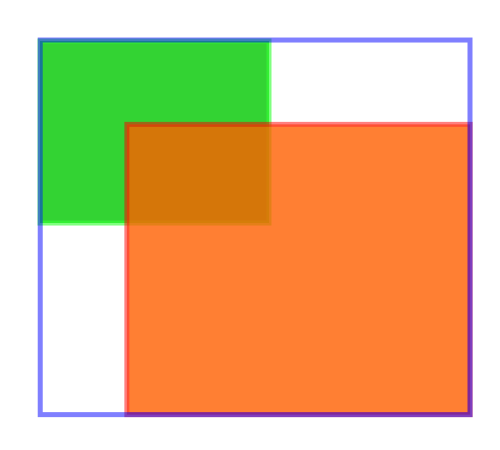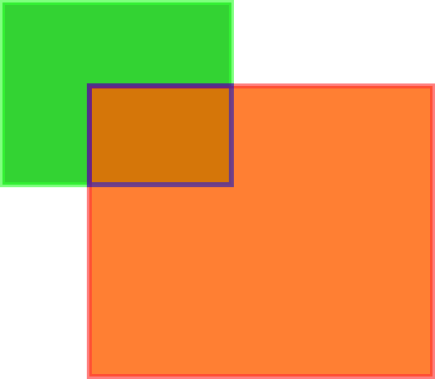| Top |
graphene_rect_t is a type representing a rectangle through an origin graphene_point_t point and a graphene_size_t size.

Operations on a graphene_rect_t will normalize the rectangle, to ensure that the origin is always the top-left corner of the rectangle and that the size is always positive.
#define GRAPHENE_RECT_INIT(_x,_y,_w,_h)
Initializes a graphene_rect_t when declaring it.
_x |
the X coordinate of the origin |
|
_y |
the Y coordinate of the origin |
|
_w |
the width |
|
_h |
the height |
Since: 1.0
graphene_rect_t *
graphene_rect_alloc (void);
Allocates a new graphene_rect_t.
The contents of the returned rectangle are undefined.
Since: 1.0
void
graphene_rect_free (graphene_rect_t *r);
Frees the resources allocated by graphene_rect_alloc().
Since: 1.0
graphene_rect_t * graphene_rect_init (graphene_rect_t *r,float x,float y,float width,float height);
Initializes the given graphene_rect_t with the given values.
This function will implicitly normalize the graphene_rect_t before returning.
r |
||
x |
the X coordinate of the |
|
y |
the Y coordinate of the |
|
width |
the width of the |
|
height |
the height of the |
Since: 1.0
graphene_rect_t * graphene_rect_init_from_rect (graphene_rect_t *r,const graphene_rect_t *src);
Initializes r
using the given src
rectangle.
This function will implicitly normalize the graphene_rect_t before returning.
Since: 1.0
bool graphene_rect_equal (const graphene_rect_t *a,const graphene_rect_t *b);
Checks whether the two given rectangle are equal.
Since: 1.0
graphene_rect_t *
graphene_rect_normalize (graphene_rect_t *r);
Normalizes the passed rectangle.
This function ensures that the size of the rectangle is made of positive values, and that the origin is the top-left corner of the rectangle.
Since: 1.0
void graphene_rect_normalize_r (const graphene_rect_t *r,graphene_rect_t *res);
Normalizes the passed rectangle.
This function ensures that the size of the rectangle is made of positive values, and that the origin is in the top-left corner of the rectangle.
Since: 1.4
void graphene_rect_get_center (const graphene_rect_t *r,graphene_point_t *p);
Retrieves the coordinates of the center of the given rectangle.
Since: 1.0
void graphene_rect_get_top_left (const graphene_rect_t *r,graphene_point_t *p);
Retrieves the coordinates of the top-left corner of the given rectangle.
Since: 1.0
void graphene_rect_get_top_right (const graphene_rect_t *r,graphene_point_t *p);
Retrieves the coordinates of the top-right corner of the given rectangle.
Since: 1.0
void graphene_rect_get_bottom_right (const graphene_rect_t *r,graphene_point_t *p);
Retrieves the coordinates of the bottom-right corner of the given rectangle.
Since: 1.0
void graphene_rect_get_bottom_left (const graphene_rect_t *r,graphene_point_t *p);
Retrieves the coordinates of the bottom-left corner of the given rectangle.
Since: 1.0
float
graphene_rect_get_x (const graphene_rect_t *r);
Retrieves the normalized X coordinate of the origin of the given rectangle.
Since: 1.0
float
graphene_rect_get_y (const graphene_rect_t *r);
Retrieves the normalized Y coordinate of the origin of the given rectangle.
Since: 1.0
float
graphene_rect_get_width (const graphene_rect_t *r);
Retrieves the normalized width of the given rectangle.
Since: 1.0
float
graphene_rect_get_height (const graphene_rect_t *r);
Retrieves the normalized height of the given rectangle.
Since: 1.0
float
graphene_rect_get_area (const graphene_rect_t *r);
Compute the area of given normalized rectangle.
Since: 1.10
void graphene_rect_get_vertices (const graphene_rect_t *r,graphene_vec2_t vertices[]);
Computes the four vertices of a graphene_rect_t.
Since: 1.4
void graphene_rect_union (const graphene_rect_t *a,const graphene_rect_t *b,graphene_rect_t *res);
Computes the union of the two given rectangles.

The union in the image above is the blue outline.
Since: 1.0
bool graphene_rect_intersection (const graphene_rect_t *a,const graphene_rect_t *b,graphene_rect_t *res);
Computes the intersection of the two given rectangles.

The intersection in the image above is the blue outline.
If the two rectangles do not intersect, res
will contain
a degenerate rectangle with origin in (0, 0) and a size of 0.
Since: 1.0
bool graphene_rect_contains_point (const graphene_rect_t *r,const graphene_point_t *p);
Checks whether a graphene_rect_t contains the given coordinates.
Since: 1.0
bool graphene_rect_contains_rect (const graphene_rect_t *a,const graphene_rect_t *b);
Checks whether a graphene_rect_t fully contains the given rectangle.
Since: 1.0
graphene_rect_t * graphene_rect_offset (graphene_rect_t *r,float d_x,float d_y);
Offsets the origin by d_x
and d_y
.
The size of the rectangle is unchanged.
Since: 1.0
void graphene_rect_offset_r (const graphene_rect_t *r,float d_x,float d_y,graphene_rect_t *res);
Offsets the origin of the given rectangle by d_x
and d_y
.
The size of the rectangle is left unchanged.
r |
||
d_x |
the horizontal offset |
|
d_y |
the vertical offset |
|
res |
return location for the offset rectangle. |
[out caller-allocates] |
Since: 1.4
graphene_rect_t * graphene_rect_inset (graphene_rect_t *r,float d_x,float d_y);
Changes the given rectangle to be smaller, or larger depending on the given inset parameters.
To create an inset rectangle, use positive d_x
or d_y
values; to
create a larger, encompassing rectangle, use negative d_x
or d_y
values.
The origin of the rectangle is offset by d_x
and d_y
, while the size
is adjusted by (2 * @d_x, 2 * @d_y). If d_x
and d_y
are positive
values, the size of the rectangle is decreased; if d_x
and d_y
are
negative values, the size of the rectangle is increased.
If the size of the resulting inset rectangle has a negative width or height then the size will be set to zero.
Since: 1.0
void graphene_rect_inset_r (const graphene_rect_t *r,float d_x,float d_y,graphene_rect_t *res);
Changes the given rectangle to be smaller, or larger depending on the given inset parameters.
To create an inset rectangle, use positive d_x
or d_y
values; to
create a larger, encompassing rectangle, use negative d_x
or d_y
values.
The origin of the rectangle is offset by d_x
and d_y
, while the size
is adjusted by (2 * @d_x, 2 * @d_y). If d_x
and d_y
are positive
values, the size of the rectangle is decreased; if d_x
and d_y
are
negative values, the size of the rectangle is increased.
If the size of the resulting inset rectangle has a negative width or height then the size will be set to zero.
r |
||
d_x |
the horizontal inset |
|
d_y |
the vertical inset |
|
res |
return location for the inset rectangle. |
[out caller-allocates] |
Since: 1.4
graphene_rect_t *
graphene_rect_round_to_pixel (graphene_rect_t *r);
graphene_rect_round_to_pixel has been deprecated since version 1.4 and should not be used in newly-written code.
Use graphene_rect_round() instead
Rounds the origin and the size of the given rectangle to their nearest integer values; the rounding is guaranteed to be large enough to contain the original rectangle.
Since: 1.0
void graphene_rect_round (const graphene_rect_t *r,graphene_rect_t *res);
graphene_rect_round has been deprecated since version 1.10 and should not be used in newly-written code.
Use graphene_rect_round_extents() instead
Rounds the origin and size of the given rectangle to
their nearest integer values; the rounding is guaranteed
to be large enough to have an area bigger or equal to the
original rectangle, but might not fully contain its extents.
Use graphene_rect_round_extents() in case you need to round
to a rectangle that covers fully the original one.
This function is the equivalent of calling floor on
the coordinates of the origin, and ceil on the size.
Since: 1.4
void graphene_rect_round_extents (const graphene_rect_t *r,graphene_rect_t *res);
Rounds the origin of the given rectangle to its nearest integer value and and recompute the size so that the rectangle is large enough to contain all the conrners of the original rectangle.
This function is the equivalent of calling floor on
the coordinates of the origin, and recomputing the size
calling ceil on the bottom-right coordinates.
If you want to be sure that the rounded rectangle completely covers the area that was covered by the original rectangle — i.e. you want to cover the area including all its corners — this function will make sure that the size is recomputed taking into account the ceiling of the coordinates of the bottom-right corner. If the difference between the original coordinates and the coordinates of the rounded rectangle is greater than the difference between the original size and and the rounded size, then the move of the origin would not be compensated by a move in the anti-origin, leaving the corners of the original rectangle outside the rounded one.
Since: 1.10
void graphene_rect_expand (const graphene_rect_t *r,const graphene_point_t *p,graphene_rect_t *res);
Expands a graphene_rect_t to contain the given graphene_point_t.
Since: 1.4
void graphene_rect_interpolate (const graphene_rect_t *a,const graphene_rect_t *b,double factor,graphene_rect_t *res);
Linearly interpolates the origin and size of the two given rectangles.
a |
||
b |
||
factor |
the linear interpolation factor |
|
res |
return location for the interpolated rectangle. |
[out caller-allocates] |
Since: 1.0
const graphene_rect_t *
graphene_rect_zero (void);
Returns a degenerate rectangle with origin fixed at (0, 0) and a size of 0, 0.
Since: 1.4
void graphene_rect_scale (const graphene_rect_t *r,float s_h,float s_v,graphene_rect_t *res);
Scales the size and origin of a rectangle horizontaly by s_h
,
and vertically by s_v
. The result res
is normalized.
r |
||
s_h |
horizontal scale factor |
|
s_v |
vertical scale factor |
|
res |
return location for the scaled rectangle. |
[out caller-allocates] |
Since: 1.10
#define GRAPHENE_RECT_INIT_ZERO GRAPHENE_RECT_INIT (0.f, 0.f, 0.f, 0.f)
Initializes a graphene_rect_t to a degenerate rectangle with an origin in (0, 0) and a size of 0.
Since: 1.10
typedef struct {
graphene_point_t origin;
graphene_size_t size;
} graphene_rect_t;
The location and size of a rectangle region.
The width and height of a graphene_rect_t can be negative; for instance, a graphene_rect_t with an origin of [ 0, 0 ] and a size of [ 10, 10 ] is equivalent to a graphene_rect_t with an origin of [ 10, 10 ] and a size of [ -10, -10 ].
Application code can normalize rectangles using graphene_rect_normalize();
this function will ensure that the width and height of a rectangle are
positive values. All functions taking a graphene_rect_t as an argument
will internally operate on a normalized copy; all functions returning a
graphene_rect_t will always return a normalized rectangle.
graphene_point_t |
the coordinates of the origin of the rectangle |
|
graphene_size_t |
the size of the rectangle |
Since: 1.0